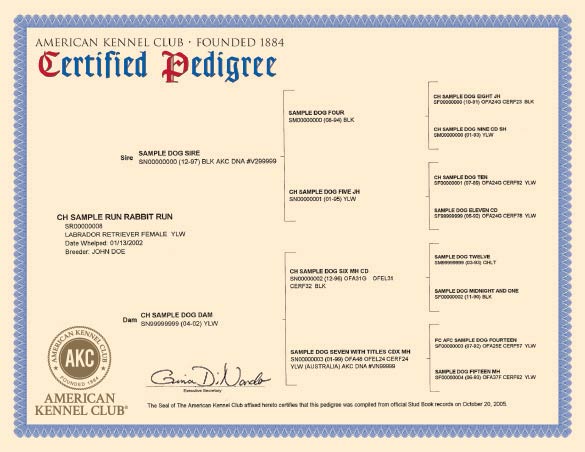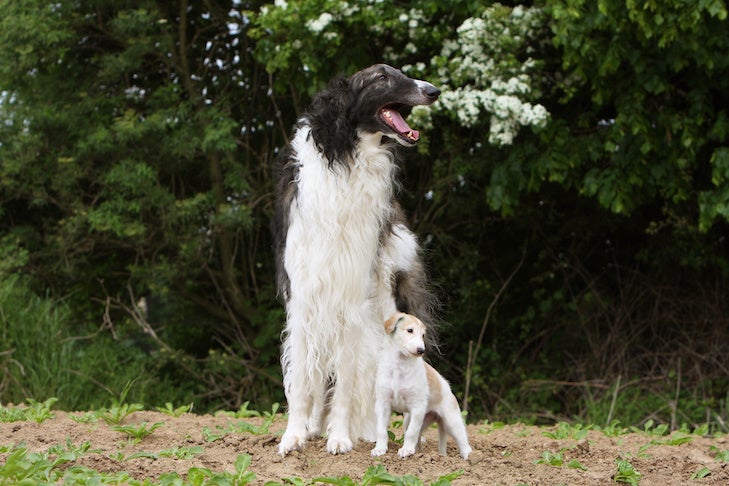Your dog’s pedigree is essentially the family tree for your dog. Perusing your dog’s pedigree, you may notice some names that re-occur, possibly because they were popular sires of their day.
Perhaps you will notice certain dogs with a lot of AKC titles, such as Champion (CH), Field Champion (FC), Companion Dog (CD), or one of many others before or after the registered name. The pedigree may also tell you if a dog was imported from another country, has DNA on file, has certain health clearances, or even what color it was.
Certain “first names” may be repeated. Dog naming conventions might have the breeder’s kennel name preceding the rest of the name, as in “Royalty’s Sir Pantsalot.” In this case “Royalty” is the kennel name. Less often the kennel name is last, or sometimes the last name is used to denote the new owner’s kennel name. So “Sir Pantsalot of Royalty” was probably bred by Royalty kennels. “Royalty Sir Pantsalot of Shady Acres” was probably bred by Royalty and owned by Shady Acres. Knowing the kennel names behind your dog enables you to know your dog’s “line,” or family within the breed. It also helps you find related dogs should you wish to add a new dog to your family.
Sometimes breeders will use litter themes, perhaps naming all the puppies in one litter after rock stars or planets, for example; or may use a litter letter, so all registered names in the litter start with the same letter. Having a litter theme or letter is useful for identifying possible littermates in a pedigree.
If you have access to books about your breed you may find photos of your dog’s ancestors in them. If you Google the names, especially ones that have a lot of titles or seem to have been popular sires, you may find some famous dogs in the mix.
Understanding the pedigree can help you better appreciate your dog’s unique ancestry, better understand their place in breed history, and if you plan to breed, better choose the optimal breeding partner.

A Dog’s AKC Ancestry Pedigree
Three types of AKC pedigrees are available: A printed Certified Pedigree, which is an official document needed if you plan to export a dog or their frozen semen; an online Research Pedigree that you can print yourself, but may not be accepted as an official document by other canine registries; and an Export Pedigree; which merges into all the information required to obtain registration with foreign kennel clubs into one document. All contain the same essential information and are read the same way.
The AKC pedigree is a traditional ancestry pedigree, meaning it is a record of your dog’s direct ancestors, reading from your dog on the left through successive generations branching to the right.
If you start with your dog at the left, you can read each progressive generation to the right. The two names to the right of your dog are your dog’s sire (on top) and dam (on the bottom), which is carried out through every generation. You will sometimes hear people talking about the tail-male or sire line, which means the top line of the entire pedigree, which is made up of only sires; or the tail-female or dam line, which is the bottom line of the entire pedigree and made up of only dams.
Go back one generation and you have sire and dam; the next generation you have their sires and dams—your dog’s grandparents—and the next generation is your dog’s great-grandparents, and so on. For many of the older breeds, the only thing preventing you from tracing every ancestor back to the 1800s is the size of your paper, as the number quickly gets out of hand!
You may notice certain dogs’ names are repeated multiple times in the pedigree. In fact, if you traced the pedigree back far enough, it would probably trace back to fewer than 100 founding dogs for each breed.

Other Types of Dog Pedigrees
The traditional ancestry pedigree is a valuable breeding tool for determining the “depth of pedigree.” This is a term used to describe the traits and assets of the ancestors in the first three or four generations (usually the 14 ancestors in the first three generations). Are they mostly Champions? Do most have certain health clearances? This information about the direct ancestors can be very important.
Equally important is the “breadth of pedigree.” In this case, the siblings of each of your dog’s ancestors are also considered. Even if the direct ancestors have good hips, for example, what if none of their littermates do? That changes the picture. The breadth of pedigree gives you more information than the depth of pedigree, but it can get complicated to absorb everything. In some cases, you have to balance the information from the depth of pedigree with that from the breadth of pedigree to make your best breeding decision. Obviously, the ideal case is to have both strong depth and breadth of pedigree.
You can also consult a pedigree of your dog’s descendants. This would originate with your dog and list offspring and their offspring for several generations. This “descendant pedigree” can also yield valuable information, especially if you are considering a dog for breeding. What if they have clear hips, but most of their progeny don’t? Again, you may need to balance this information with other pros and cons related to the pedigree, and again, it can get complicated.
The best way to combine all the information from direct ancestors, siblings, and descendants into one pedigree is to use a trait or symbol pedigree, which is often used in medical and genetic research. In such a pedigree, males are shown as squares and females as circles. Horizontal lines connect breeding pairs, and vertical lines reach down to their offspring. Dogs affected with the trait of interest are colored dark; those unaffected are uncolored; those known to be carriers may be colored half-and-half. Such pedigrees are typically used to determine if a trait is passed on in a dominant or recessive or even sex-linked mode of inheritance.
Your dog’s pedigree is a valuable research tool as well as an important record of the breeding decisions that led to your dog’s existence. It’s something to be studied and cherished—truly a point of pride and a perk of being a purebred.

